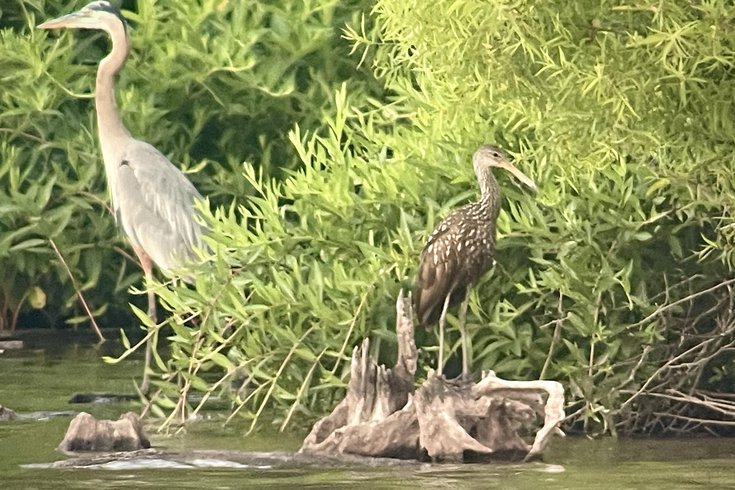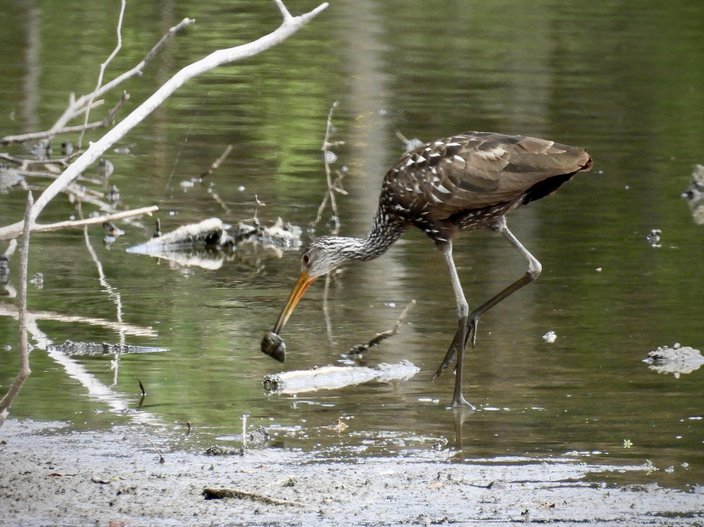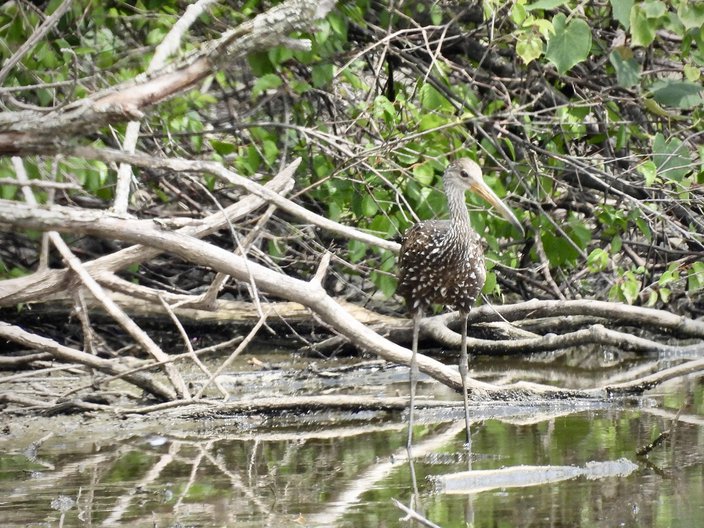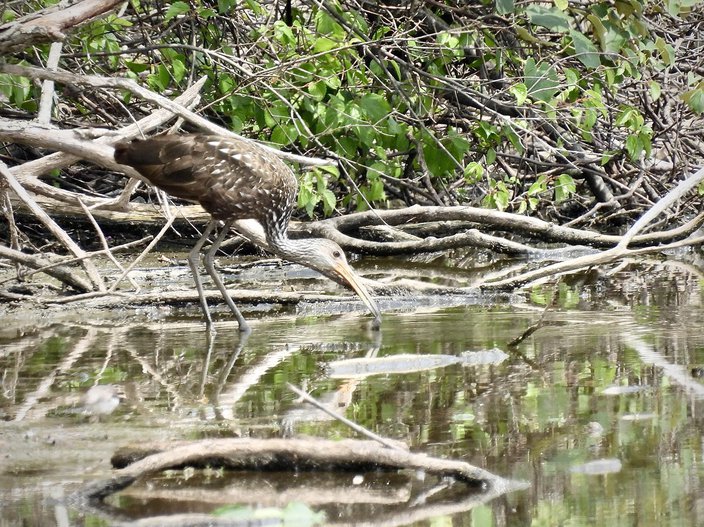
July 13, 2023
 Ted Nichols II/Lancaster County Bird Club
Ted Nichols II/Lancaster County Bird Club
A limpkin, shown on the right in this digiscoped photo , stands next to a blue heron at the Middle Creek Wildlife Management Area in Lancaster County on Monday. Limpkins are tropical birds. This is the first one to be documented in Pennsylvania.
Avid bird watchers flocked to Lancaster County last weekend to get a look at bird that made its first recorded appearance in Pennsylvania.
The limpkin, a wading bird species related to cranes and rails, was observed in the Middle Creek Wildlife Management Area last Friday. The Lancaster County Bird Club said more than 100 people visited from across the state and beyond to get a glimpse the next day, many with binoculars and cameras ready. As many as 500 or more made it out during the three days it remained visible in the area.
"This bird could have easily decided to instead drop in on some area that was inaccessible to the public or that simply isn't checked regularly," Ted Nichols II, the club's president, said Thursday. "Instead, it picked a place with great habitat, lots of food and excellent public access to enable viewing of it — birders really hit the jackpot with this one!"
In the United States, limpkins historically have been native to Florida and Georgia, but they have increasingly dispersed to states further north after they breed. The expanding range has been enabled by the spread of invasive snails, one of the limpkin's favorite meals. Their growing territory is a dramatic turnaround from earlier points in time when habitat loss in the southeast seemed to put their long-term survival in the U.S. in jeopardy.
"Amazingly, this is a species that wasn't removed from Florida's endangered species list until 2017," Nichols said. "However, since then everything has been working in its favor to extend its range and contribute to it venturing outward during post-breeding dispersal of the species from these locations."
Limpkin sightings have been documented in the Mid-Atlantic, the Midwest and as far west as Oklahoma, Colorado and Texas in recent years. To the north, prior to its appearance in Pennsylvania, it also had been seen in New York and parts of Canada. The species is commonly found in Mexico and in Central and South America, although the limpkins farther south were considered a distinct species until the 1930s.
Nichols said limpkins now breed in South Carolina and other states surrounding Florida. They are not migratory birds, but their expanded breeding territory has helped the adults explore other parts of the country in between breeding. Limpkins are generally solitary birds that tend to be tame and approachable, within reason, if they are in areas where they're not threatened by reptiles. They're known for a loud, wailing call.
"It's primary food source — snails — is also plentiful as a rapid expansion of several different types of invasive snail species are spreading throughout waterways across our country, including into the Northeast, and there isn't near as much competition with this particular food source in the bird world," Nichols said. "All of these things — which have their own nuances and contributors — are fueling the Limpkin being seen at many new places across the U.S. in recent years."
The limpkin was photographed snacking on July 10.
Another photo of the limpkin on July 10.
A photograph of the limpkin at the Middle Creek Wildlife Management Area on July 8.
One of the limpkin's favorites snacks, invasive apple snails, have been competing with smaller native apple snails in Florida. The larger snail species has implications for a number of bird species. The endangered snail kite's rebound, for example, is partly attributed to the spread of the invasive snails that have increased the food supply, but there are also concerns that the larger snails are too big for young snail kites to eat. More broadly, the invasive snails spreading in Florida's wetlands could be harming plant species and disrupting the ecosystem.
The snail species eaten by the limpkin in Lancaster County was confirmed through photos to be a Chinese mystery snail, another invasive species, Nichols said. Apart from snails, limpkins like to eat freshwater mussels and also sometimes eat insects, crustaceans, worms, frogs and lizards.
Some conservationists say the expanded ranges of the limpkin and other southeast wetlands species — including the purple gallinule, white ibis and black-bellied whistling duck — are predictable effects of climate change and should be viewed as warnings even as they show certain species adapting to changes in their environments.
The limpkin spotted in Lancaster County has either been in hiding in an area of the refuge not visible to the public or is believed to have moved on from the area, after sticking around for a few days. The photograph Nichols took Monday, when he observed the limpkin next to a blue heron, is the last known photo of the bird. Nichols said he stayed with the bird until dark and was likely the last to have observed it in the area.
"It really was a joy to see so many people get to enjoy the first-ever record of this bird at one of our best birding locations in Lancaster County," Nichols said.
 Ted Nichols III/Lancaster County Birding Club
Ted Nichols III/Lancaster County Birding Club Ted Nichols II/Lancaster County Birding Club
Ted Nichols II/Lancaster County Birding Club Ted Nichols II/Lancaster County Birding Club
Ted Nichols II/Lancaster County Birding Club